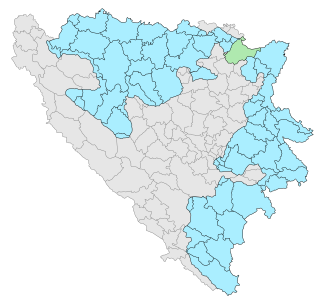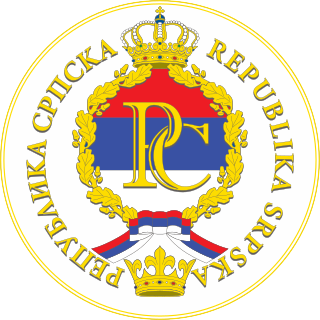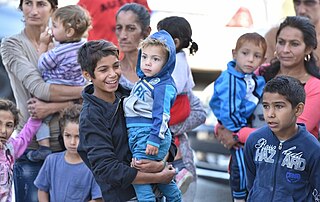
Bosnia and Herzegovina is a country in Southeast Europe, situated on the Balkan Peninsula. It borders Serbia to the east, Montenegro to the southeast, and Croatia to the north and southwest. In the south it has a 20 kilometres long coast on the Adriatic Sea, with the town of Neum being its only access to the sea. Bosnia has a moderate continental climate with hot summers and cold, snowy winters. In the central and eastern regions, the geography is mountainous, in the northwest it is moderately hilly, and in the northeast it is predominantly flat. Herzegovina, the smaller, southern region, has a Mediterranean climate and is mostly mountainous. Sarajevo is the capital and the largest city.

Demographic features of the population of Bosnia and Herzegovina include population density, ethnicity, education level, health of the populace, economic status, religious affiliations and other aspects of the population.
The politics of Bosnia and Herzegovina are defined by a parliamentary, representative democratic framework, where the Chairman of the Council of Ministers of Bosnia and Herzegovina, named by the Presidency of Bosnia and Herzegovina, is the head of government. Executive power is exercised by the Council of Ministers of Bosnia and Herzegovina and the Presidency of Bosnia and Herzegovina. Legislative power is vested in both the Council of Ministers and the Parliamentary Assembly of Bosnia and Herzegovina. Members of the Parliamentary Assembly are chosen according to a proportional representation system. The judiciary is independent of the executive and the legislature.

Republika Srpska is one of the two entities of Bosnia and Herzegovina, the other being the Federation of Bosnia and Herzegovina. It is located in the north and east of the country. Its largest city and administrative centre is Banja Luka, lying on the Vrbas river, and with a population of about 138,963 people.

The Federation of Bosnia and Herzegovina is one of the two entities composing Bosnia and Herzegovina, the other being Republika Srpska. The Federation of Bosnia and Herzegovina consists of ten autonomous cantons with their own governments and legislatures.

The Posavina Canton is one of ten cantons of the Federation of Bosnia and Herzegovina in Bosnia and Herzegovina. It is the smallest canton with an area of only 330.85 km2 (128 sq mi). The canton is an exclave of Federation of Bosnia and Herzegovina, being bordered by Republika Srpska and Brčko District to the south and the river Sava and Croatia to the north. Its capital is Orašje and the largest town is Odžak.
There is currently no official flag for the Federation of Bosnia and Herzegovina. The federation is part of the state of Bosnia and Herzegovina. The federation adopted its own flag in 1996, but the flag and associated coat of arms were deemed unconstitutional by the Constitutional Court of Bosnia and Herzegovina in 2007 and now it is considered to be a "de facto" flag. The federation has not yet adopted a new flag, anthem or coat of arms; instead the symbols of the central state are used for official purposes as a provisional solution.

Under the "Law on Territorial Organization and Local Self-Government" adopted in 1994, Republika Srpska was divided into 80 municipalities. After the conclusion of the Dayton Peace Agreement, the law was amended in 1996 to reflect the changes to the entity's borders and now provides for the division of Republika Srpska into 64 municipalities.

Milorad Dodik is a Bosnian Serb politician serving as the 8th president of Republika Srpska since 2022. Previously, he served as the 7th Serb member of the Presidency of Bosnia and Herzegovina from 2018 to 2022.

The Republic of Bosnia and Herzegovina was a state in Southeastern Europe, existing from 1992 to 1995. It is the direct legal predecessor to the modern-day state of Bosnia and Herzegovina.

The Seal of Republika Srpska with the description: the flag of Republika Srpska and the Cyrillic letters "РС" ("RS"), the red-blue-white tricolor are in the center of the seal, twisted with the golden Oak leaves, a traditional pre-Christian symbol sacred to most Slavs. On the edge of the seal there is an inscription Republika Srpska. The open crown of Kotromanić is shown in the bottom of the seal and the seal itself is topped with a heraldic royal crown.

The mass media of Bosnia and Herzegovina refers to mass media outlets based in Bosnia and Herzegovina (BiH). Television, radio, magazines and newspapers are all operated by both state-owned and for-profit corporations which depend on advertising, subscription, and other sales-related revenues. The Constitution of Bosnia and Herzegovina guarantees freedom of speech, although political and business pressures - coupled with administrative fragmentation - still hinder the independence of journalists and media outlets.
Telecommunications in Bosnia and Herzegovina include radio, television, fixed and mobile telephones, and the Internet.

The Xoraxane in Bosnia and Herzegovina are the largest of the 17 national minorities in the country, although—due to the stigma attached to the label—this is often not reflected in statistics and censuses.

Report about Case Srebrenica (the first part) was a controversial official report on the July 1995 Srebrenica massacre in eastern Bosnia and Herzegovina. It was prepared by Darko Trifunović and published by the Republika Srpska Government Bureau for Relations with the International Criminal Tribunal for the Former Yugoslavia (ICTY).
The most recent census of Bosnia and Herzegovina, the 2013 census, took place from 1 October until 15 October 2013 with a reference date of census 30 September 2013 at 24:00 hours (midnight), 22 years after the previous census. It was the first census after the Bosnian War. It was organized by the Central Census Bureau of Bosnia and Herzegovina and supported by the European Union.

Željka Cvijanović is a Bosnian Serb politician serving as the 8th and current Serb member of the Presidency of Bosnia and Herzegovina since 2022. She previously served as the 9th president of Republika Srpska from 2018 to 2022.

The legislation of Bosnia and Herzegovina recognises three constituent peoples and 17 national minorities. These latter include 2.73% of the total population of the country, i.e. 96,539 persons. The biggest community is the Romani people in Bosnia and Herzegovina, which are estimated at around 58,000 persons.

General elections were held in Bosnia and Herzegovina on 2 October 2022. They decided the makeup of Bosnia and Herzegovina's Presidency as well as national, entity, and cantonal governments.















